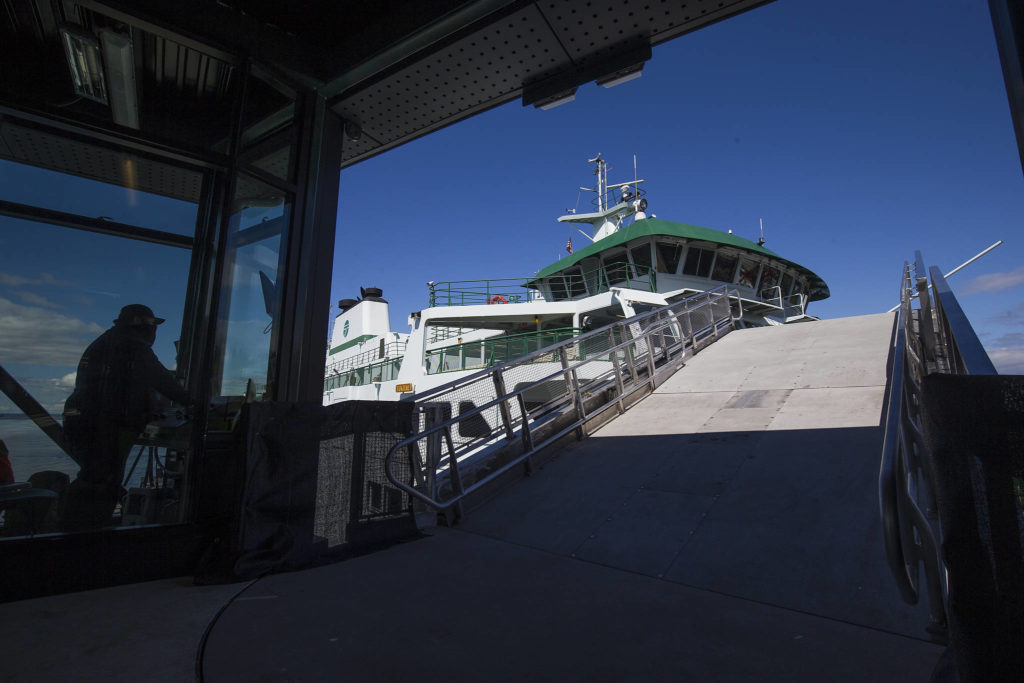MUKILTEO — In with the “pickle forks” and out with the “zebra stripes.”
That’s some of the lingo when talking shop with state officials about progress at the $187 million ferry terminal that opened in late 2020.
The “pickle forks” are those protruding prongs that secure the ferry to the overhead boarding walkway to ensure passengers crossing the gate don’t topple into the sea. The walkway was put into service on Monday, four months after the terminal’s first sailing on Dec. 29.
Traffic issues on Highway 525 should improve later next week when a black-and-white “zebra striped” pedestrian crosswalk at Second Street is moved to a site uphill from the fray, after months of public safety issues.
“We’re getting really close to getting all these elements done,” said Diane Rhodes, Washington State Ferries spokesperson.
For the first time in 64 years, walk-on passengers on the Mukilteo-Clinton route have their own boarding ramp and don’t have to use the car deck. That’s the way it had been since the old terminal was built in 1957.
They now also get an Instagram-worthy photo op.
“It opens up the views,” Rhodes said. “You get this stunning view over the water that you’ve never had before. At the end, there’s a solid glass area that looks out at Whidbey Island. It’s a nice place to linger.”
By linger she means snap a pic, not stand around eating an ice cream cone.
The walkway is only accessed by a turnstile on the second floor of the terminal. Getting there requires using the stairs or elevators at both ends. Tickets can be ordered online or purchased at a kiosk or window.
The walkway is dog friendly.
“It’s wonderful,” said Mona Thomas, who was taking her little dog Flower to visit family members on Whidbey. “I like this better than the other way.”
Flower seemed pretty jazzed to strut the breezy gangplank.
Commuter scooters are allowed on the walkway. Bicyclists must board on the car deck, though unicycles are OK.
“If you have a disability or you’re in a wheelchair it’s a lot easier to go on that nice wide walkway to go onto the vessel versus having to go on the car deck,” Rhodes said.
There are four ADA drop-off spots on the east side of the terminal, she said. A kiss-and-go lane allows for passenger drop-off and pickup.
The Mukilteo-Clinton route has about 2 million vehicles and 4 million riders each year. Boats leave every half hour for the 20-minute sailing.
Getting to the Mukilteo terminal is getting easier.
Road paving that started last week has opened one lane in each direction on the straight shot to the toll gates, replacing the winding road that had been used. Crews are still paving the two other lanes, which, when finished in mid-May, will provide four-lane access.
The Second Street crosswalk has been an ongoing problem with foot and car traffic since the new terminal opened, Rhodes said.
“We’ve thrown everything at it to try to make it safer, but people are just not stopping for pedestrians in that crosswalk,” she said.
The crosswalk will be moved up the hill to the Fifth Street intersection that has a traffic light until the new crosswalk at First Street is complete. Crews also are building sidewalks on First Street.
The warm weather and longer hours of daylight increase ferry traffic, especially after a winter of confinement.
“We still suggest people go during off-peak hours if they can,” Rhodes said. “And we still do have COVID restrictions in place. Limit travel to essential travel only.”
Some people consider a ferry ride essential.
Andrea Brown: abrown@heraldnet.com; 425-339-3443. Twitter @reporterbrown.
Talk to us
> Give us your news tips.
> Send us a letter to the editor.
> More Herald contact information.






























